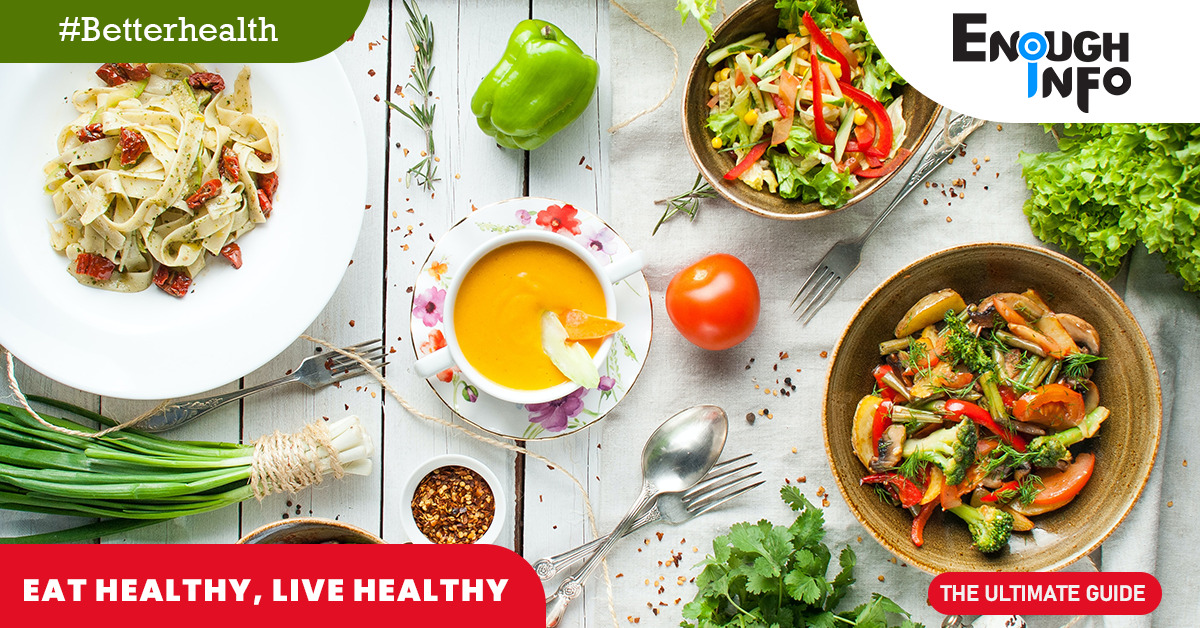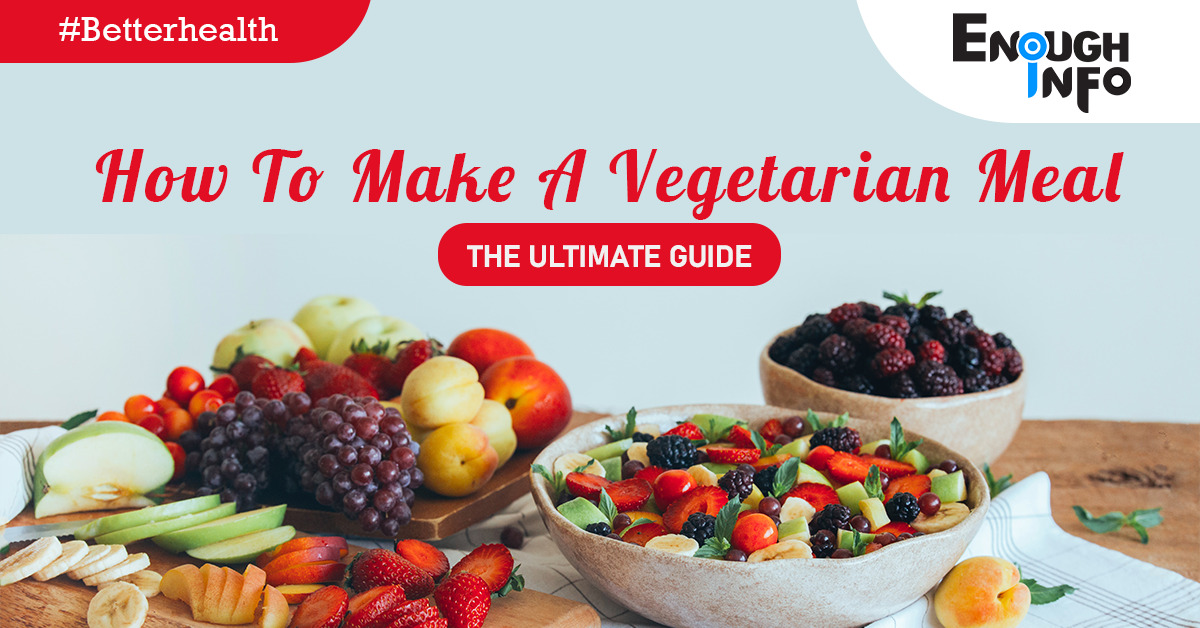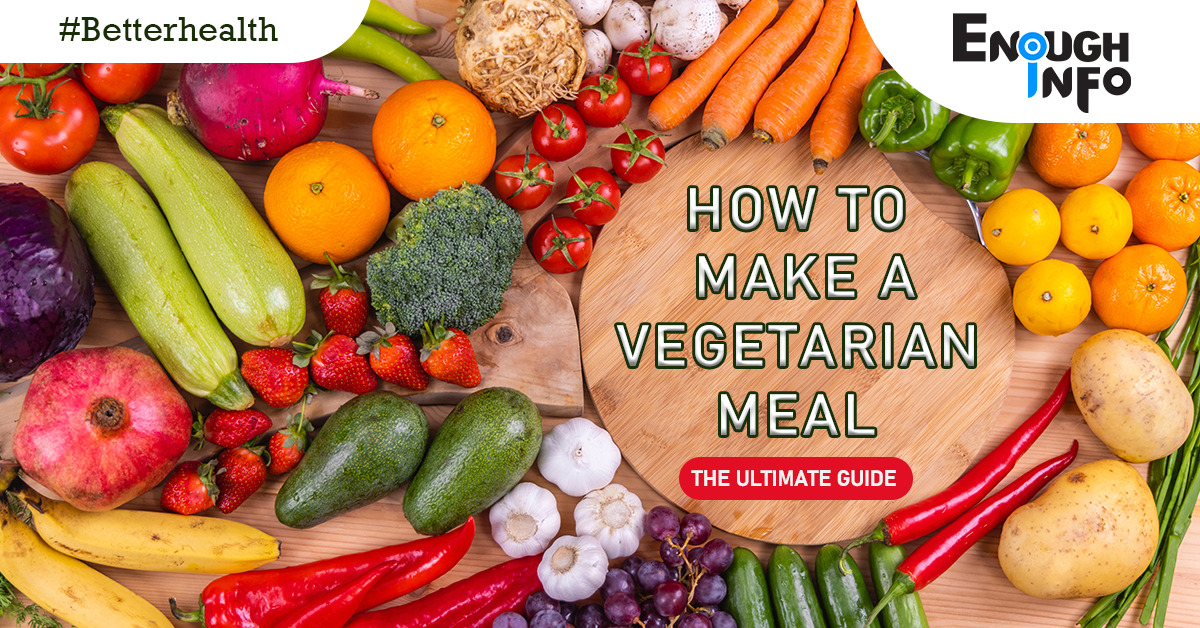
How To Make A Vegetarian Meal: Vegetarian meals have gained popularity in recent years due to their health benefits, reduced environmental impact, and ethical considerations. Whether you’re a seasoned vegetarian or someone looking to incorporate more plant-based meals into your diet, this comprehensive guide will provide you with the knowledge and inspiration to create delicious vegetarian dishes. EnoughInfo.com

Read Also: 6-Day Low Carb Meal Plan Ideas(The Ultimate Guide)
Understanding how to make vegetarian meals is important for accommodating dietary preferences and restrictions. When hosting gatherings or cooking for a group, having vegetarian options ensures that everyone can enjoy the meal. It promotes inclusivity and allows you to cater to different dietary needs without compromising on taste or nutritional value. How To Style Curly Hair (The Ultimate Guide)
Learning how to make vegetarian meals is important for personal health, environmental sustainability, animal welfare, culinary exploration, inclusivity, and aligning dietary choices with personal values. By embracing vegetarian cooking, individuals can enjoy a diverse and satisfying range of meals that are not only beneficial to their well-being but also have a positive impact on the planet and the lives of animals.
FAQs & Answers on How To Make A Vegetarian Meal
1. Is a vegetarian diet suitable for everyone?
2. Can I get enough protein on a vegetarian diet?
Absolutely! While animal products are commonly associated with protein, there are numerous plant-based protein sources that can fulfill your protein requirements. Legumes like beans, lentils, and chickpeas, as well as tofu, tempeh, seitan, quinoa, nuts, and seeds, are all excellent sources of plant-based protein. By incorporating a variety of these protein-rich foods into your meals, you can easily meet your protein needs.
3. How can I ensure I’m getting all the necessary nutrients on a vegetarian diet?
While a well-planned vegetarian diet can provide all the necessary nutrients, it’s important to pay attention to key nutrients like iron, calcium, vitamin B12, omega-3 fatty acids, and vitamin D. Include iron-rich foods like leafy greens, legumes, and fortified grains, and pair them with vitamin C-rich foods to enhance iron absorption. Incorporate calcium sources like dairy alternatives, fortified plant-based milks, tofu, and leafy greens. Consider a vitamin B12 supplement or consuming fortified foods, as this vitamin is mainly found in animal products. For omega-3 fatty acids, include flaxseeds, chia seeds, walnuts, and algae-based supplements. Lastly, vitamin D can be obtained through sunlight exposure or fortified foods, but supplementation may be necessary, especially in regions with limited sunlight.
4. How can I make vegetarian meals more flavorful?
Vegetarian meals can be bursting with flavor by using a variety of herbs, spices, and condiments. Experiment with options like garlic, ginger, cumin, turmeric, paprika, cinnamon, basil, oregano, cilantro, and lemon juice to add depth and enhance the taste of your dishes. Additionally, explore different cooking techniques like roasting, grilling, and sautéing to bring out the natural flavors of vegetables and plant-based proteins.
5. Can I still enjoy my favorite dishes as a vegetarian?
Absolutely! With the availability of plant-based alternatives, you can often recreate vegetarian versions of your favorite dishes. For example, you can make veggie burgers, vegetarian lasagna, plant-based “meat”balls, or even tofu or tempeh stir-fries. Get creative with ingredient substitutions and experiment with flavors and textures to create vegetarian versions of your beloved recipes.
6. Are there any resources available for vegetarian cooking inspiration?
Vegetarian recipes are abundant. Yotam Ottolenghi, Angela Liddon, and Deborah Madison have vegetarian cookbooks. Minimalist Baker, Cookie and Kate, Oh She Glows, Love and Lemons, and Naturally Ella provide many vegetarian recipes. Join online vegetarian communities, forums, or social media groups to share recipes with like-minded people. How To Make Homemade Salsa
Remember, vegetarian cooking is fun and brings up a world of flavors and possibilities. Vegetarian meals may be tasty, healthy, and sustainable with a little imagination and investigation.
Read Also: How to Build a Sustainable and Healthy Diet Plan (2023)
Creating Delicious Vegetarian Meals: A Comprehensive Guide To Wholesome And Flavorful Plant-Based Cooking

From understanding the basic principles of vegetarian cooking to exploring a variety of recipes, this article will empower you to craft wholesome and flavorful vegetarian meals that will satisfy your taste buds and nourish your body.
1. Understanding Vegetarianism:
a. What is a Vegetarian Diet? A vegetarian diet excludes meat, poultry, seafood, and sometimes dairy and eggs. It primarily focuses on plant-based foods such as fruits, vegetables, grains, legumes, nuts, and seeds.
b. Health Benefits of a Vegetarian Lifestyle: A vegetarian diet has been associated with numerous health benefits, including reduced risk of heart disease, type 2 diabetes, certain cancers, and obesity. It tends to be higher in fiber, vitamins, minerals, and antioxidants while being lower in saturated fat and cholesterol.
c. Key Nutrients in a Vegetarian Diet: Vegetarian diets can provide all the essential nutrients if well-planned. Key nutrients to focus on include protein, iron, calcium, vitamin B12, omega-3 fatty acids, and vitamin D. It’s important to incorporate a variety of plant-based protein sources, fortified foods, and consider supplementation if necessary. How To Clean A Clogged Drain
2. Building a Well-Balanced Vegetarian Meal:
a. Plant-Based Protein Sources: Include a variety of protein-rich foods such as legumes (beans, lentils, chickpeas), tofu, tempeh, seitan, edamame, quinoa, hemp seeds, chia seeds, and nuts. These sources offer essential amino acids and can be used as the foundation for protein-rich main dishes or incorporated into salads, stir-fries, and grain bowls.
b. Incorporating Whole Grains: Whole grains like brown rice, quinoa, bulgur, farro, and whole wheat pasta are excellent sources of fiber, vitamins, and minerals. They provide sustained energy and can be used as a base for pilafs, grain salads, or as a side dish alongside vegetable-based mains.
c. Embracing a Rainbow of Vegetables: Vegetables are the star of any vegetarian meal, providing an array of flavors, textures, and nutrients. Incorporate a variety of colorful vegetables like leafy greens, bell peppers, carrots, broccoli, cauliflower, zucchini, eggplant, and tomatoes. Roast, sauté, steam, or grill them to enhance their natural flavors.
d. Healthy Fats and Plant-Based Oils: Include healthy fats in your vegetarian meals by incorporating sources like avocado, olive oil, coconut oil, nuts, seeds, and nut butters. These provide essential fatty acids and contribute to the overall taste and satisfaction of your dishes. How To Start A Successful Podcast
e. Adding Flavor with Herbs and Spices: Enhance the flavor profile of your vegetarian meals by using a wide range of herbs, spices, and condiments. Experiment with options like garlic, ginger, cumin, turmeric, paprika, cinnamon, basil, oregano, cilantro, and lemon juice. They can elevate the taste of your dishes and provide added health benefits.
Read Also: How To Create A Meal Plan For Weight Loss
3. Essential Cooking Techniques for Vegetarian Meals:
a. Sautéing and Stir-Frying: Sautéing and stir-frying are quick and versatile methods that allow you to cook vegetables, tofu, tempeh, and seitan over high heat. These techniques retain the natural crunch, color, and nutrients of the ingredients while infusing them with flavor.
b. Roasting and Grilling: Roasting and grilling are perfect for bringing out the natural sweetness and enhancing the textures of vegetables. It caramelizes the sugars and imparts a smoky flavor that adds depth to your vegetarian dishes. How To Make A DIY Face Mask For Oily Skin
c. Steaming and Boiling: Steaming and boiling are gentle methods suitable for cooking delicate vegetables, grains, and legumes. They help retain nutrients while creating tender and moist results.
d. Simmering and Stewing: Simmering and stewing are ideal for creating hearty and comforting vegetarian meals. It allows flavors to meld together, making them perfect for soups, stews, and curries.
e. Using Different Cooking Methods for Different Ingredients: Understanding which cooking method suits each ingredient is crucial. For example, some vegetables are best roasted, while others are better steamed or sautéed. Adapt your techniques based on the desired texture and flavor of each ingredient.
4. Recipe Ideas for Breakfast, Lunch, and Dinner:
a. Flavorful Breakfast Bowls and Smoothies: Start your day with a nourishing vegetarian breakfast bowl or smoothie. Create combinations of whole grains, yogurt or plant-based milk, fruits, nuts, and seeds. Top with a drizzle of honey, maple syrup, or nut butter for added sweetness.
b. Creative and Filling Lunch Salads: Prepare vibrant and satisfying salads by combining leafy greens, roasted vegetables, beans or lentils, grains, and a variety of toppings. Experiment with different dressings, such as lemon tahini, balsamic vinaigrette, or citrus-infused olive oil.
c. Hearty and Satisfying Dinner Entrees: Explore a wide range of vegetarian dinner options like lentil loaf, vegetable stir-fries, stuffed bell peppers, mushroom risotto, spinach and feta stuffed Portobello mushrooms, vegetable curry, vegetarian lasagna, and homemade veggie burgers. These dishes provide substantial protein, complex carbohydrates, and a variety of flavors and textures. How To Write A Captivating Blog Post
d. Nourishing Soups and Stews: Warm up with hearty vegetarian soups and stews like lentil soup, vegetable minestrone, tomato and basil soup, butternut squash soup, or chickpea and vegetable stew. These dishes are packed with nutrients and can be enjoyed as a main course or paired with a side salad or crusty bread.
e. Exciting Side Dishes and Accompaniments: Complement your meals with delicious vegetarian side dishes like roasted root vegetables, quinoa pilaf, garlic sautéed greens, sweet potato fries, or herbed couscous. These add variety and depth to your meals while providing additional nutrients.

5. Snacks and Desserts:
a. Wholesome Snack Options: Keep your energy levels up with nutritious vegetarian snacks such as homemade granola bars, trail mix, roasted chickpeas, fruit with nut butter, yogurt parfaits with fresh fruits and granola, or veggie sticks with hummus.
b. Delicious Vegetarian Desserts: Indulge your sweet tooth with vegetarian desserts like fruit crisps, dark chocolate avocado mousse, coconut chia pudding, banana bread, apple cinnamon muffins, or homemade berry sorbet. These treats can be enjoyed guilt-free while satisfying your cravings.
Read Also: How to make a vegan dessert
6. Meal Planning and Prepping:
a. Benefits of Meal Planning: Meal planning saves time, reduces food waste, and ensures you have nutritious meals throughout the week. It allows you to shop efficiently, prepare ingredients in advance, and have a clear roadmap for your vegetarian meals.
b. Creating a Weekly Meal Plan: Design a weekly meal plan by selecting a variety of breakfast, lunch, dinner, and snack options. Consider incorporating leftovers, using similar ingredients across multiple meals, and ensuring a balance of flavors, textures, and nutrients.
c. Efficient Meal Prep Tips and Techniques: Streamline your cooking process by prepping ingredients ahead of time. Wash and chop vegetables, cook grains and legumes, and prepare sauces or dressings in advance. Store them properly to maintain freshness and ease of use. How To Remove Pet Hair From Furniture
d. Storage and Reheating Suggestions: Store leftovers and prepped ingredients in airtight containers in the refrigerator or freezer. Label them with dates and reheating instructions. Use proper reheating methods to retain flavors and textures.
7. Exploring Global Vegetarian Cuisine:
a. Mediterranean Delights: Explore Mediterranean vegetarian cuisine with dishes like Greek salad, falafel, tabbouleh, hummus, spanakopita, or ratatouille. These recipes showcase fresh ingredients, vibrant flavors, and healthy fats.
b. Asian-inspired Dishes: Discover the diverse flavors of Asian vegetarian dishes such as vegetable stir-fries, tofu and vegetable curries, sushi rolls, pad Thai with tofu, or vegetable spring rolls. Experiment with soy sauce, ginger, lemongrass, and other traditional Asian spices.
c. Mexican and Latin American Flavors: Enjoy the bold and spicy flavors of Mexican and Latin American vegetarian dishes like black bean tacos, vegetable enchiladas, quinoa-stuffed bell peppers, guacamole, or plantain chips with salsa. These dishes are packed with vibrant colors and robust flavors.
d. Indian and Middle Eastern Spices: Delve into the aromatic and rich flavors of Indian and Middle Eastern vegetarian cuisine. Try dishes like lentil dal, vegetable biryani, chickpea curry, falafel, or stuffed grape leaves. These cuisines are known for their use of spices like cumin, coriander, turmeric, cardamom, and cinnamon, which add depth and complexity to vegetarian dishes.
e. Fusion Creations: Get creative by combining flavors and techniques from different cuisines to create unique vegetarian fusion dishes. For example, you can make a Thai-inspired quinoa salad, a Mexican-inspired tofu scramble, or a Mediterranean-inspired stuffed sweet potato. The possibilities are endless.
8. Resources for Vegetarian Cooking:
a. Cookbook Recommendations: Explore vegetarian cookbooks authored by renowned chefs and experts, such as “Plenty” by Yotam Ottolenghi, “The Oh She Glows Cookbook” by Angela Liddon, “Vegetarian India” by Madhur Jaffrey, and “Vegetarian Cooking for Everyone” by Deborah Madison.
b. Online Recipe Sources and Blogs: Find inspiration from popular vegetarian recipe websites and blogs like Minimalist Baker, Cookie and Kate, Oh She Glows, Love and Lemons, and Naturally Ella. These platforms offer a wide range of delicious and healthy vegetarian recipes.
c. Cooking Classes and Workshops: Consider enrolling in vegetarian cooking classes or workshops in your area. These hands-on experiences can help you learn new techniques, expand your culinary skills, and connect with other vegetarian food enthusiasts.
d. Vegetarian Community and Support: Join online vegetarian communities, forums, or social media groups to connect with like-minded individuals. These communities can provide support, recipe suggestions, and a platform to share your own vegetarian creations.
Read Also: 24 Best Energy-Boosting Foods(All You Need To Know)
Conclusion:
Creating delicious vegetarian meals is a rewarding and enjoyable culinary journey. By understanding the principles of vegetarian cooking, building a well-balanced meal, mastering essential cooking techniques, and exploring a variety of recipes, you can craft wholesome and flavorful vegetarian dishes that cater to your taste preferences and dietary needs. Whether you’re looking for quick and simple meals, international flavors, or indulgent desserts, the world of vegetarian cuisine offers endless possibilities. Embrace the versatility of plant-based ingredients, experiment with flavors, and enjoy the benefits of a nourishing and sustainable vegetarian lifestyle.
Recommended;
Top Healthy Foods To Eat Everyday(2023 Guide)
11 Ways To Gain Healthy Weight Fast Naturally(2023 Guide)




